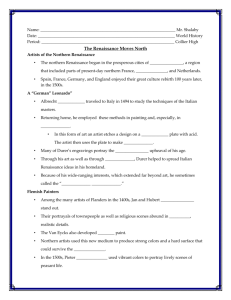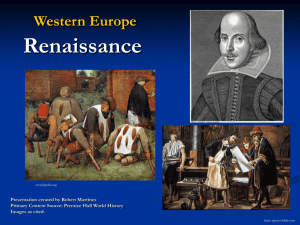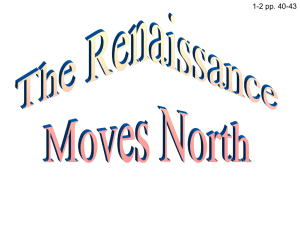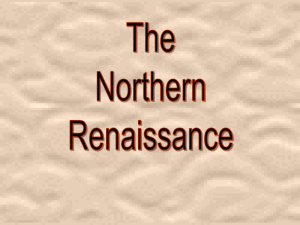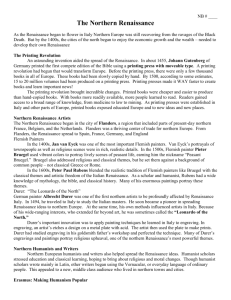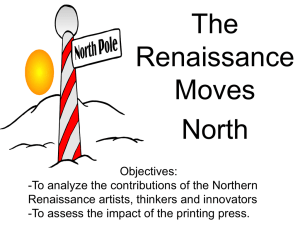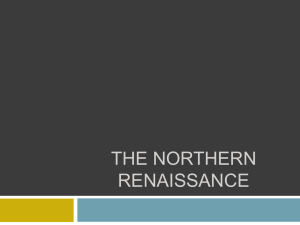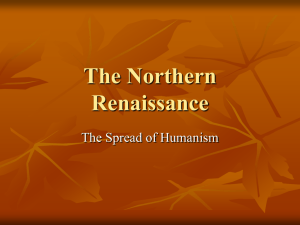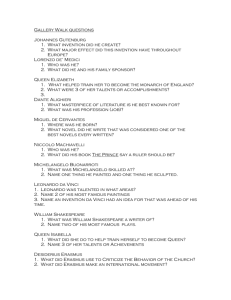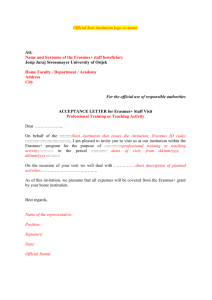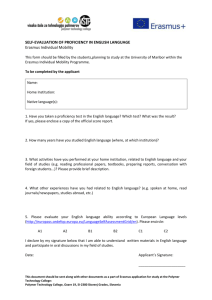The Renaissance Moves North
advertisement
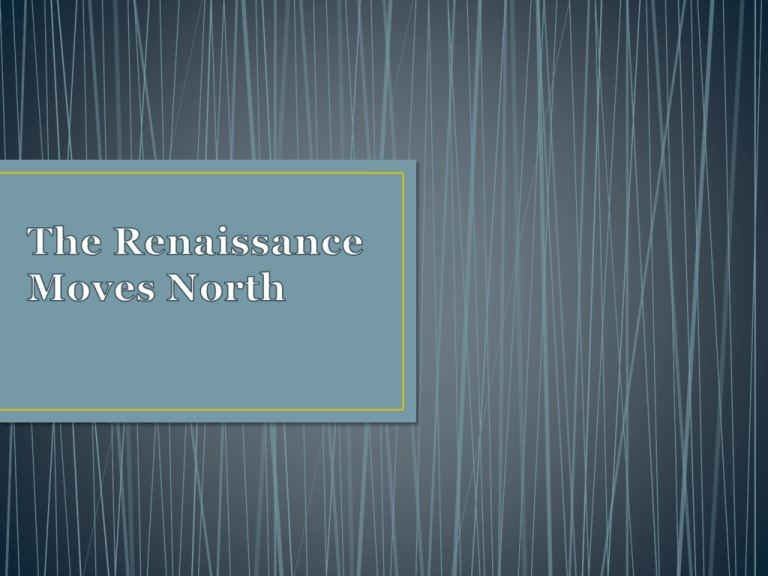
• The northern Renaissance began in the prosperous cities of Flounders, a region that included parts of present-day northern France, Belgium, and Netherlands. • Spain, France, Germany, and England enjoyed their great culture rebirth 100 years later, in the 1500s. • Albrecht Durer traveled to Italy in 1494 to study the techniques of the Italian masters. • Returning home, he employed these methods in painting and, especially, in engravings. • In this form of art an artist etches a design on a metal plate with acid. The artist then uses the plate to make prints. • Many of Durer’s engravings portray the religious upheaval of his age. • Through his art as well as through essays, Durer helped to spread Italian Renaissance ideas in his homeland. • Because of his wide-ranging interests, which extended far beyond art, he sometimes called the “German Leonardo.” • Among the many artists of Flanders in the 1400s, Jan and Hubert Van Eyck stand out. • Their portrayals of townspeople as well as religious scenes abound in rich, realistic details. • The Van Eycks also developed oil paint. • Northern artists used this new medium to produce strong colors and a hard surface that could survive the centuries. • In the 1500s, Pieter Bruegel used vibrant colors to portray lively scenes of peasant life. • Bruegel’s work influenced later Flemish artists, who painted scenes of daily life rather than religious or classical themes. • In the 1600s, Peter Paul Rubens blended he realistic tradition of Flemish painters like Bruegel with the classical themes and artistic freedom of the Italian Renaissance. • Many of his enormous paintings portray pagan figures from the classical past. • Like Italian humanists, northern European humanist scholars stressed education and classical learning. • At the same time, they emphasized religious themes. • They believed that the revival of ancient learning should be used to bring about religious and moral reform • Dutch priest and humanist Desiderius Erasmus used his knowledge of classical languages to produce a new Greek edition of the New Testament. • He also called for a translation of the Bible into the vernacular, or everyday language of ordinary people. • As a priest he was disturbed by corruption in the Church and called for reform • In The Praise of Folly, Erasmus used humor to expose the ignorant and immortal behavior of many people of his day including the clergy. • Erasmus’s friend, the English humanist Thomas More, also pressed for social reform. • In Utopia, More describes an ideal society in which men and women live in peace and harmony. • No one is idle, all are educated, and justice is used to end crime rather than to eliminate the criminal. • Scholars like More and Erasmus wrote mostly in Latin. • In northern towns and cities, the growing middle class demanded new works in the vernacular. • The audience particularly enjoyed dramatic tales and earthy comedies • The French humanist Francois Rabelais had a varied career as a monk, physician, Greek scholar, and author. • In Gargantua and Pantagruel, he chronicle the adventure of two gentle giants. • On the surface, the novel is a comic tale on travel and war. But Rabelais uses his characters to offer opinion on religion, education, and other serious subjects. • Between 1590 and 1613 William Shakespeare wrote 37 plays. • Shakespeare’s comedies, such as Twelfth Night laugh at the follies of young people in love. • His history plays, such as Richard III, depict the powerful struggles of English kings. • His tragedies show people crushed by powerful forces or their own weaknesses. • Wrote 154 sonnets on the subjects of love, beauty & mortality • Shakespeare’s love of words vastly enriched the English language. • More than 1,700 words appeared for the first time in his works, including bedroom, lonely, gloomy, heartsick, hurry and sneak. • In 1456, Johann Gutenberg of Mainz, Germany, printed the first complete edition of the Bible using the first printing press and printing inks in the West. • Within 20 years, the development of movable type made book production even easier. • A printing revolution would transform Europe. • By 1500, more than 20 million volumes had been printed. • Printed books were cheaper and easier to produce than handcopied work. • With books more readily available, more people learned how to read. • Printed books exposed educated Europeans to new ideas, greatly expanding their horizons
